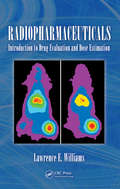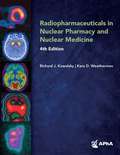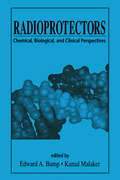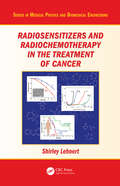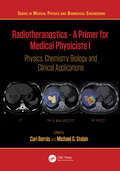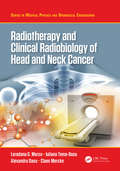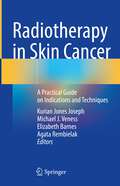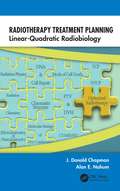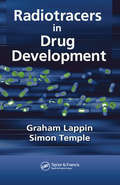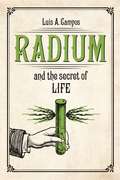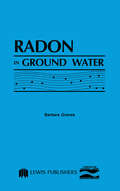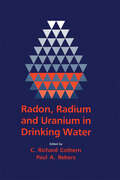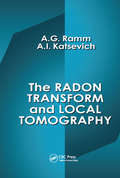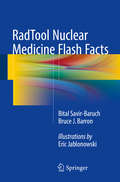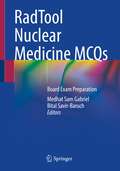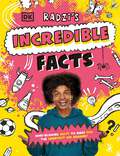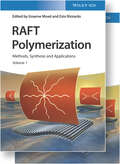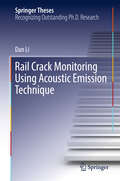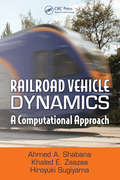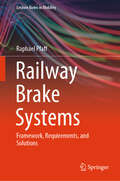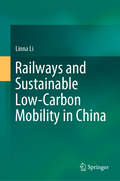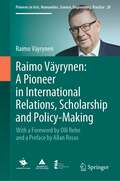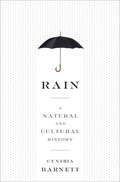- Table View
- List View
Radiopharmaceuticals: Introduction to Drug Evaluation and Dose Estimation
by Ph.D., Lawerence WilliamsNanoengineering, energized by the desire to find specific targeting agents, is leading to dramatic acceleration in novel drug design. However, in this flurry of activity, some issues may be overlooked. This is especially true in the area of determining dosage and evaluating the effects of multiple agents designed to target more than one site of met
Radiopharmaceuticals and Brain Pathophysiology Studied with Pet and Spect: Studied With Pet And Spect (Routledge Revivals)
by M. Diksic Richard C. RebaFirst published in 1991, this book covers three major areas essential to in vivo biochemical studies with PET and SPECT: synthesis of radiopharmaceuticals, biological modeling, and clinical applications. The book emphasizes advances in the synthesis of radiopharmaceuticals used in PET and SPECT studies of brain flow and oxidatative metabolism, in addition to biological modeling. The most widely used 2-deoxyglucose/2-fluorodeoxyglucose models are discussed, as well as models used in the quantitation of brain receptors. Other topics include a possible model for converting 6-[18F] fluorodopa images into the quantitative rate of dopamine synthesis, evaluations of technetium- and iodine-labeled blood flow tracers, and possibilities for using SPECT to measure other pathophysiological variables. This book will be a valuable reference source to students and specialists interested in these in vivo measurements.
Radiopharmaceuticals in Nuclear Pharmacy and Nuclear Medicine
by Richard J. Kowalsky Kara D. WeathermanAs with previous editions of this textbook, Radiopharmaceuticals in Nuclear Pharmacy and Nuclear Medicine, Fourth Edition, provides a comprehensive introduction to radiopharmaceuticals and their applications in nuclear medicine. With the increasing emphasis on PET and the expanding role of theranostics, the nuclear medicine community continues to grow as evidenced by the development of several new radiopharmaceuticals and technologies for diagnostic and therapeutic applications in recent years. The book is intended for use in courses taught in the disciplines of nuclear pharmacy, nuclear medicine technology, and nuclear medicine. The chapter topics are of moderate depth and breadth and are referenced to the primary literature. As such, this textbook has become a useful resource for professional practitioners in these disciplines and for those preparing for specialty board examination.
Radioprotectors: Chemical, Biological, and Clinical Perspectives
by Edward A. Bump Kamal MalakerIt is essential to minimize damage to normal tissues during radiation therapy and many strategies have been employed in finding the best methods for radioprotection. This book integrates chemical, biological, and clinical perspectives on these strategies and developments, providing a comprehensive treatise. It emphasizes new concepts in radioprotection, aiming to inspire further basic science and clinical progress in radioprotector research. Radioprotectors: Chemical, Biological, and Clinical Perspectives includes the following topics:Early research on radioprotectorsWR-2721, an aminothiol prodrug, as a radioprotectorNew results with naturally occurring thiolsNitroxides as effective radioprotectors in vitro and in vivoRadioprotection observed with radical scavengers or antioxidantsBone marrow radioprotection with cytokines and biological modifiersMultiple mechanisms of altering radiation response by eicosanoidsVascular response to radiation and the importance of vascular damage to normal tissue Modifiers of radiation-induced apoptosisSurvey of clinical trials with radioprotectorsRadiation biologists and oncologists, cancer researchers, and toxicologists will benefit from the findings discussed and strategies for future research.
Radiosensitizers and Radiochemotherapy in the Treatment of Cancer (Series in Medical Physics and Biomedical Engineering)
by Shirley LehnertRadiosensitizers and Radiochemotherapy in the Treatment of Cancer catalogs and describes the mechanism of action for entities characterized as radiosensitizers. Developments in the biological and physical sciences have introduced new radiosensitizers and defined novel targets for radiosensitization. As a result, a book about radiosensitization must
Radiotheranostics - A Primer for Medical Physicists I: Physics, Chemistry, Biology and Clinical Applications (ISSN)
by Cari Borrás Michael G. StabinThis book covers scientific, clinical, and educational aspects of radiotheranostics in cancer control. Setting the framework, the first volume defines radiotheranostics and describes the history of radionuclide therapy and theranostics, and the biology of cancer. It examines the clinical applications of unconjugated radionuclides, such as ¹³¹I and ²²³Ra, and of radionuclide-conjugated cancer-specific vectors: peptides, small molecules, antibodies, and nanoparticles; introduces clinical trials and drug development; and reviews epidemiological studies and the adverse effects of radionuclide therapy – both radiation injuries and chemical toxicity. It presents the chemistry and physics of radionuclide production, discusses radioactivity measurements and traceability, and addresses important instrumentation aspects: calibration, quantitative imaging, and quality control. Volume I concludes with guidance on the education, training, and competence of a radiotheranostic multidisciplinary team and summarizes the principal physics characteristics of theranostics today – including many to be expanded in the second volume – while offering a glimpse into tomorrow. This volume provides the foundations for the more advanced second volume, which explores dosimetric and radiation safety, aiming to empower medical physicists and demonstrate to the cancer community how to improve cancer control and yield increased patient survival times.It will be a valuable reference for medical and health physicists with basic knowledge of nuclear medicine.Key Features• Provides a comprehensive introduction to the topic, presenting readers with thorough treatment in a cohesive two-volume book.• Presents a rigorous approach while remaining accessible to students and trainees in the field.• Contains consistent and extensive references to allow readers to delve deeper into the subject.
Radiotherapy and Clinical Radiobiology of Head and Neck Cancer (Series in Medical Physics and Biomedical Engineering)
by Loredana G. Marcu Iuliana Toma-Dasu Alexandru Dasu Claes MerckeCommon factors that lead to treatment failure in head and neck cancer are the lack of tumour oxygenation, the accelerated division of cancer cells during treatment, and radioresistance. These tumour-related challenges and possible ways to overcome them are covered in this book, authored by three medical physicists and a clinical oncologist who explain how different radiobiological findings have led to the development of various treatment techniques for head and neck cancer. <P><P>Novel treatment techniques as supported by current scientific evidence are comprehensively explored, as well as the major challenges that arise in the retreatment of patients who have already undergone a form of radiotherapy for primary head and neck cancer. <P><P>Features: <li>Uses an interdisciplinary approach, encompassing clinical aspects of radiotherapy, radiation biology, and medical physics <li>Applies content by relating all radiobiological characteristics to their respective clinical implications <li>Explains the radiobiological rationale for all previous and current clinical trials for head and neck cancer
Radiotherapy in Skin Cancer: A Practical Guide on Indications and Techniques
by Kurian Jones Joseph Michael J. Veness Elizabeth Barnes Agata RembielakRadiotherapy is one of the major treatment modalities utilised for the management of patients diagnosed with skin cancer. This book describes the indications and the various radiotherapy techniques used to treat skin cancer. The technical details of radiotherapy are well addressed and serve as a practical reference to those clinicians involved in managing these patients. The authors are all leading radiation oncologists from the major cancer centers in the USA, Canada, UK & Australia. Skin Radiotherapy is an essential resource for practicing medical professionals such as radiation oncologists, dermatologists, radiation therapists and residents preparing for board examinations.
Radiotherapy Treatment Planning: Linear-Quadratic Radiobiology
by J. Donald Chapman Alan E. NahumUnderstand Quantitative Radiobiology from a Radiation Biophysics PerspectiveIn the field of radiobiology, the linear-quadratic (LQ) equation has become the standard for defining radiation-induced cell killing. Radiotherapy Treatment Planning: Linear-Quadratic Radiobiology describes tumor cell inactivation from a radiation physics perspective and of
Radiotracers in Drug Development
by Graham Lappin Simon TempleAlthough there are numerous books on drug metabolism, Radiotracers in Drug Development is unique in explaining how radiotracers are used to elucidate a drug's absorption, distribution, metabolism, and excretion (ADME). Covering traditional and recent technologies and applications, the book takes a strong industrial approach, discussing the b
Radium and the Secret of Life
by Luis A. CamposBefore the hydrogen bomb indelibly associated radioactivity with death, many chemists, physicians, botanists, and geneticists believed that radium might hold the secret to life. Physicists and chemists early on described the wondrous new element in lifelike terms such as “decay” and “half-life,” and made frequent references to the “natural selection” and “evolution” of the elements. Meanwhile, biologists of the period used radium in experiments aimed at elucidating some of the most basic phenomena of life, including metabolism and mutation. From the creation of half-living microbes in the test tube to charting the earliest histories of genetic engineering, Radium and the Secret of Life highlights previously unknown interconnections between the history of the early radioactive sciences and the sciences of heredity. Equating the transmutation of radium with the biological transmutation of living species, biologists saw in metabolism and mutation properties that reminded them of the new element. These initially provocative metaphoric links between radium and life proved remarkably productive and ultimately led to key biological insights into the origin of life, the nature of heredity, and the structure of the gene. Radium and the Secret of Life recovers a forgotten history of the connections between radioactivity and the life sciences that existed long before the dawn of molecular biology.
The Radium Girls: The Scary but True Story of the Poison that Made People Glow in the Dark
by Kate MooreExplore the unbelievable true story of America's glowing girls and their fight for justice in the young readers edition of the New York Times and USA Today bestseller The Radium Girls. This enthralling new edition includes all-new material, including a glossary, timeline, and dozens of bonus photos.Amid the excitement of the early twentieth century, hundreds of young women spend their days hard at work painting watch dials with glow-in-the-dark radium paint. The painters consider themselves lucky—until they start suffering from a mysterious illness. As the corporations try to cover up a shocking secret, these shining girls suddenly find themselves at the center of a deadly scandal.The Radium Girls: Young Readers Edition tells the unbelievable true story of these incredible women, whose determination to fight back saved countless lives.This new edition of the national bestseller is perfect for:Educators looking for history books for kids ages 9 to 12, nonfiction books for kids, biographies for kids, and real stories around the industrial revolution, chemistry, and scienceParents, educators, and librarians looking for stories about strong women, inspiring books for girls, childrens books about women in history, and famous women books for girlsYoung readers who want to read one of the most inspiring and shocking narratives of the early 20th century
Radon in Ground Water
by National Water Well Assoc.This new book focuses on sampling and analysis, radon and radium in water supply wells, predictive models, geologic and hydrogeologic controls that influence radon occurrence, monitoring radon and other radioactivity from geologic sources and mining impacts on occurrence of radioactivity in ground water. Also discussed are occurrence, testing, treatment, and reduction of radon from groundwater. Because the most severe health hazard from indoor radioactivity results from inhalation of short-lived radioactive decay products of radon, the EPA scheduled a major conference early in 1987 on Radon, Radium, and Other Radioactivity in Ground Water-Hydrogeologic Impact and Application to Indoor Airborne Contamination. The result is this book.
Radon, Radium, and Uranium in Drinking Water
by C. Richard CothernWith new regulations for radionuclides in drinking water, this volume will be valuable for understanding where radionuclides come from, how their prescence is determined, where humans come in contact with them, health effects consequences (both for individuals and communities), removal from water, disposal problems and cost implications.
The Radon Transform and Local Tomography
by Alexander G. Ramm Alex I. KatsevichOver the past decade, the field of image processing has made tremendous advances. One type of image processing that is currently of particular interest is "tomographic imaging," a technique for computing the density function of a body, or discontinuity surfaces of this function. Today, tomography is widely used, and has applications in such fields as medicine, engineering, physics, geophysics, and security. The Radon Transform and Local Tomography clearly explains the theoretical, computational, and practical aspects of applied tomography. It includes sufficient background information to make it essentially self-contained for most readers.
RadTool Nuclear Medicine Flash Facts
by Bital Savir-Baruch Bruce J. BarronThis book is a learning aid and reference tool that provides all the important information pertaining to radioactive tracers within a single, easy-to-read volume. It introduces a new learning methodology that will help the reader to recall key facts on each tracer, including production, physical and chemical characteristics, study protocols, mechanism of action, distribution, and clearance. In addition, normal and abnormal tracer distributions are graphically reproduced on an outline of the human body using multiple colors. The book will be of value for all radiologists and medical students seeking a reliable source of essential information on radioactive tracers that can be readily consulted during everyday practice and used in preparation for examinations.
RadTool Nuclear Medicine MCQs: Board Exam Preparation
by Medhat Sam Gabriel Bital Savir-BaruchThis book, in MCQ format, is a comprehensive tool that will help Nuclear Medicine and Radiology residents and attending physicians to understand concepts in nuclear medicine. Questions cover clinical applications of nuclear medicine techniques to the cardiovascular, pulmonary, endocrine, skeletal, gastrointestinal, genitourinary, and central nervous systems. In addition, topics in physics, radiopharmacy, and radiation safety are addressed. The MCQ format closely resembles that used in board examinations in nuclear medicine. Each question has four possible answers, only one of which is correct. About 60% of the questions are linked to clinical cases, with each case having four questions on average, along with one or two images. The remainder of the questions are free-standing, with or without an image. Answers are concise but are supported by references to the literature when necessary. Pearls in boxes are used to highlight the most important pieces of information. While the questions are scrambled, as in board exams, an index categorizes each question into one of the systems or topics.
Radzi's Incredible Facts: Mind-Blowing Facts to Make You the Smartest Kid Around!
by Radzi ChinyanganyaA book for curious kids filled with unforgettable facts, from the brilliant to the bizarre! What’s the furthest distance ever run without stopping? Which language has the most words? How many times do we blink each day, year, or in an entire lifetime? How deep is the deepest hole that’s ever been dug? How hot are the world’s hottest chilies? Do you know the answers? If not, then this fact book is for you.This fun and educational book for children aged 5-9 is packed with quirky questions and answers about every topic you can possibly think of. Learn about feminism, ears, pirates, and even belly buttons, Radzi’s Incredible Facts will have curious minds hooked. No question is too random for Radzi!This exciting children’s fact book offers:- Key topics for children, from bizarre facts about the human body and incredible historical figures, to unbelievable sporting feats and amazing animals.- An intriguing question and answer format that clearly groups topics to generate interest and engage young readers.- Content by the author of well-known UK children’s television personality Radzi Chinyanganya – former presenter of the BBC’s Blue Peter.- A balance of text and illustrations on each page, making it engaging for young readers.Kids can dazzle their friends and family with unforgettable facts and astounding information from former Blue Peter presenter Radzi Chinyanganya. Young minds are so inquisitive and always asking questions! Ever wondered where to find the answers to tricky and curious questions about everything, from sleep to snow and diseases to diamonds? Then look no further! This book is brimming with questions and answers you didn’t even know you needed.
RAFT Polymerization: Methods, Synthesis, and Applications
by Graeme MoadExplore this one-stop resource for reversible addition-fragmentation chain transfer polymerization from a leading voice in chemistry RAFT Polymerization: Methods, Synthesis and Applications delivers a comprehensive and insightful analysis of reversible addition-fragmentation chain transfer polymerization (RAFT) and its applications to fields as diverse as material science, industrial chemistry, and medicine. This one-stop resource offers readers a detailed synopsis of the current state of RAFT polymerization. This text will inspire further research and continue the drive to an ever-increasing range of applications by synthesizing and explaining the more central existing literature on RAFT polymerization. It contains a beginner’s guide on how to do a RAFT polymerization before moving on to much more advanced techniques and concepts, like the kinetics and mechanisms of the RAFT process. The distinguished editors have also included resources covering the four major classes of RAFT agents and recent developments in processes for initiating RAFT polymerization. Readers will also benefit from the inclusion of: A thorough introduction to the mechanisms, theory, and mathematical modeling of RAFT Explorations of RAFT agent design and synthesis, dithioesters, dithiobenzoates, trithiocarbonates, xanthates, dithiocarbamates, macromonomer RAFT, and RAFT copolymerization Discussions of a variety of RAFT architectures, including multiblocks, combs, hyperbranched polymers, and stars Treatments of end group transformation, cationic RAFT, high-throughput RAFT, and RAFT in continuous flow An examination of sequence defined polymers by RAFT Perfect for organic chemists, polymer chemists, and materials scientists, RAFT Polymerization: Methods, Synthesis and Applications will also earn a place in the libraries of chemical engineers seeking a one-stop reference for this method of controlled radical polymerization with a wide range of applications in multiple areas.
Rail Crack Monitoring Using Acoustic Emission Technique (Springer Theses)
by Dan LiThis thesis provides an innovative strategy for rail crack monitoring using the acoustic emission (AE) technique. The field study presented is a significant improvement on laboratory studies in the literature in terms of complex rail profile and crack conditions as well as high operational noise. AE waves induced by crack propagation, crack closure, wheel-rail impact and operational noise were obtained through a series of laboratory and field tests, and analyzed by wavelet transform (WT) and synchrosqueezed wavelet transform (SWT). A wavelet power-based index and the enhanced SWT scalogram were sequentially proposed to classify AE waves induced by different mechanisms according to their energy distributions in the time–frequency domain. A novel crack sizing method taking advantage of crack closure-induced AE waves was developed based on fatigue tests in the laboratory. The propagation characteristics of AE waves in the rail were investigated, and Tsallis synchrosqueezed wavelet entropy (TSWE) with time was finally brought forward to detect and locate rail cracks in the field. The proposed strategy for detection, location and sizing of rail cracks helps to ensure the safe and smooth operation of the railway system. This thesis is of interest to graduate students, researchers and practitioners in the area of structural health monitoring.
Railroad Vehicle Dynamics: A Computational Approach
by Ahmed A. Shabana Khaled E. Zaazaa Hiroyuki SugiyamaThe methods of computational mechanics have been used extensively in modeling many physical systems. The use of multibody-system techniques, in particular, has been applied successfully in the study of various, fundamentally different applications. Railroad Vehicle Dynamics: A Computational Approach presents a computational multibody-system
Railway Brake Systems: Framework, Requirements, and Solutions (Lecture Notes in Mobility)
by Raphael PfaffThis book offers a timely introduction to railway brake systems. It introduces operational aspects as well as a set of rail vehicle specific requirements, such as wheel-rail contact and rail vehicle dynamics. It discusses the process of brake control, in particular for automatic pneumatic brake system and brake systems for multiple units. In turn, the book gives insights into braking force generation, covering both friction brake systems and regenerative brakes. It also describes performance calculations, discussing concepts for brake systems design. Despite the focus is mainly on European braking systems, the book identifies key and general aspects, thus offering an inspiring reading for researchers and professionals that are active both inside and outside of Europe.
Railways and Sustainable Low-Carbon Mobility in China
by Linna LiThis book explores the role of railways in developing sustainable low-carbon mobility by analyzing the intermodal relationship between railways and other transport modes. Focusing on geographical and governance perspectives, and taking China as a case study, it analyzes the competition and cooperation between and integration of railways and other transport modes, in order to provide guidance on future sustainable transport development. Firstly, the book examines the contribution of railways to low carbon emissions in China over recent decades by estimating the carbon dioxide emissions from various transport modes in China at national and regional levels using decomposition analysis. It then discusses the current competition and cooperation between railways and other transport modes, as well as their integration and the impact of their relationship on climate change. It also highlights how the competition between railways and other transport modes may change the passenger flows between city pairs and so alter transport carbon emissions and examines how cooperation and integration could improve passengers’ travel experience while at the same time reducing carbon emissions. Lastly, it addresses the implications for future sustainable transport development based on institutional analysis. Presenting multidisciplinary, sustainable transport research on the role of railways in reducing carbon emissions, and also offering policy recommendations for developing low-carbon, integrated transport in the future, this book is a valuable reference resource for graduates, researchers, and government managers responsible for transport development, urban planning and environmental policy.
Raimo Väyrynen: With a Foreword by Olli Rehn and a Preface by Allan Rosas (Pioneers in Arts, Humanities, Science, Engineering, Practice #28)
by Raimo VäyrynenThis book provides a broad overview of Professor Raimo Väyrynen’s academic work, his role in international research organizations, and his contributions to policy debates. It offers an interesting review of important political issues during the time span of half a century, from disarmament in Europe to the changing relationship between state sovereignty and transnational forces. Väyrynen has dealt with the changing agenda of peace and international relations, security and the arms race, and the world economy. This book provides comprehensive analyses of the regional and systemic structure of international relations, with the emphasis on conflicts and warfare between nations. It argues that while states, even smaller ones, still matter, transnational issues are increasingly important. Taking a historical perspective, the articles suggest that large-scale violence and arms races have been recurrent and cyclical phenomena in international relations. These events reflect the deep-seated inequalities in the political and economic systems which, moreover, vary considerably between regions. The publication is important reading for any researcher as well as students, policy-makers and the science-oriented public at large. • Traces the changing agenda of international relations from disarmament and the world economy to the changing relationship between state sovereignty and transnational forces. • Provides analyses of the regional and systemic structure in international relations, with the emphasis on conflicts and warfare. • Argues that large-scale violence and the arms race have been recurrent and cyclical phenomena in international relations. • Reviews important political issues from peace and conflict in Europe to the changing power relationship in the world.
Rain
by Cynthia BarnettRain is elemental, mysterious, precious, destructive. It is the subject of countless poems and paintings; the top of the weather report; the source of the world's water. Yet this is the first book to tell the story of rain. Cynthia Barnett's Rain begins four billion years ago with the torrents that filled the oceans, and builds to the storms of climate change. It weaves together science--the true shape of a raindrop, the mysteries of frog and fish rains--with the human story of our ambition to control rain, from ancient rain dances to the 2,203 miles of levees that attempt to straitjacket the Mississippi River. It offers a glimpse of our "founding forecaster," Thomas Jefferson, who measured every drizzle long before modern meteorology. Two centuries later, rainy skies would help inspire Morrissey's mopes and Kurt Cobain's grunge. Rain is also a travelogue, taking readers to Scotland to tell the surprising story of the mackintosh raincoat, and to India, where villagers extract the scent of rain from the monsoon-drenched earth and turn it into perfume. Now, after thousands of years spent praying for rain or worshiping it; burning witches at the stake to stop rain or sacrificing small children to bring it; mocking rain with irrigated agriculture and cities built in floodplains; even trying to blast rain out of the sky with mortars meant for war, humanity has finally managed to change the rain. Only not in ways we intended. As climate change upends rainfall patterns and unleashes increasingly severe storms and drought, Barnett shows rain to be a unifying force in a fractured world. Too much and not nearly enough, rain is a conversation we share, and this is a book for everyone who has ever experienced it.From the Hardcover edition.
